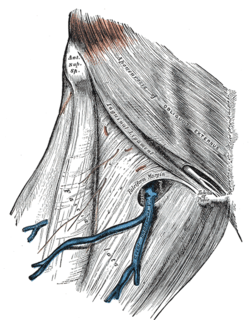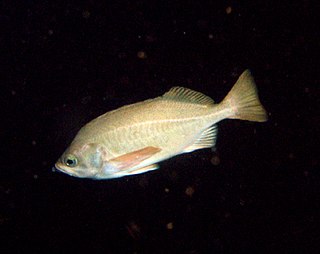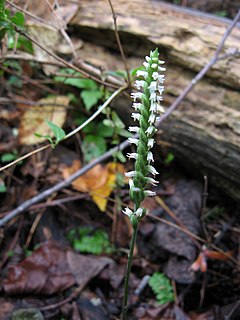Related Research Articles

The fossa ovalis is a depression in the right atrium of the heart, at the level of the interatrial septum, the wall between right and left atrium. The fossa ovalis is the remnant of a thin fibrous sheet that covered the foramen ovale during fetal development.
The family Archeocrypticidae is a small group of beetles with no vernacular common name, though recent authors have coined the name cryptic fungus beetles. Adults and larvae seems to be saprophagous and are often found in plant litter. Worldwide, about 10 genera and 50 species are found, most species are pantropical. Enneboeus caseyi has been recorded from the American South, Central America, and Mexico. About 20 species are found in Australia, in the genera Enneboeus and Australenneboeus.
Fossa ovalis can refer to:

In anatomy, the saphenous opening is an oval opening in the upper mid part of the fascia lata of the thigh. It lies 3–4 cm below and lateral to the pubic tubercle and is about 3 cm long and 1.5 cm wide.

Elachistocleis ovalis, commonly known as the common oval frog, is a dubious species of frog in the family Microhylidae. The type species of Elachistocleis, it was described without a holotype or type locality, and due to this it is not known exactly to which population the name Elachistocleis ovalis applies, making it a nomen nudum. The Amphibian Species of the World restricts this species to Panama, Colombia, Trinidad and Tobago, and Bolivia. Frog species from Brazil have been allocated to other species. A 2021 study found all populations assigned to E. ovalis across South America to represent several different undescribed species, likely indicating that the name E. ovalis is invalid without knowledge of the original population.

The striped stingaree is a common but little-known species of stingray in the family Urolophidae, endemic to shallow, inshore waters off southwestern Australia. Reaching 61 cm (24 in) long, this species is characterized by an oval, grayish to brownish disc with darker mask-like markings around the eyes and paired blotches at the center of the disc that are extended posteriorly into horizontal lines. Its nostrils have enlarged lobes on the outer margins and a skirt-shaped curtain of skin with a deeply fringed trailing margin in between. Its tail terminates in a relatively large leaf-shaped caudal fin, and bears a small dorsal fin just before the stinging spine. The rounded, flexible disc of the striped stingaree enable it to maneuver through the rocks, reefs, and seagrass that comprise its favored habitats. The International Union for Conservation of Nature (IUCN) has listed this species under Least Concern; it is seldom caught by fisheries due to its habitat preferences.
Lithocarpus ovalis is a species of plant in the family Fagaceae. It is endemic to the Philippines.
Melicope ovalis, the wild pelea or Hana melicope, is a species of tree in the family Rutaceae. It is endemic to Maui, of the Hawaiian Islands.

Amelanchier ovalis, commonly known as snowy mespilus is a serviceberry shrub. Its pome fruits are edible and can be eaten raw or cooked. The species is native to central and southern Europe, as well as North Africa and the Middle East.

Halophila ovalis, commonly known as paddle weed, spoon grass or dugong grass, is a seagrass in the family Hydrocharitaceae. It is a small herbaceous plant that occurs in sea beds and other saltwater environments in the Indo-Pacific.
Quinella is a genus of bacteria in the Veillonellaceae family. Its only species, Quinella ovalis, is an extremely large motile rumen anaerobic prokaryote previously known as "Quin's Oval".

Novisuccinea ovalis, commonly called the oval ambersnail, is a species of air-breathing land snail, a terrestrial pulmonate gastropod mollusk in the family Succineidae, the ambersnails.
In anatomy, a fossa is a depression or hollow, usually in a bone, such as the hypophyseal fossa. Some examples include:
Ovalis, oval in Latin, may refer to:
A. ovalis may refer to:
Concavodonta is an extinct genus of early bivalve in the extinct family Praenuculidae. The genus is one of three genera in the subfamily Concavodontinae. Concavodonta is known solely from late Ordovician, Caradoc epoch, fossils found in Europe and South America. The genus currently contains three accepted species, Concavodonta imbricata, Concavodonta ovalis and the type species Concavodonta ponderata.

Sebastes ovalis is a species of fish in the rockfish family found in deep rocky areas of the Eastern Pacific.

Ovali is a village in the Thane district of Maharashtra, India. It is located in the Bhiwandi taluka.

Spiranthes ovalis, commonly called the October lady's tresses, is a species of orchid that is native to eastern North America.
Şükran Ovalı is a Turkish actress.
References
- ↑ BioLib.cz - Somatocleptes ovalis. Retrieved on 8 September 2014.